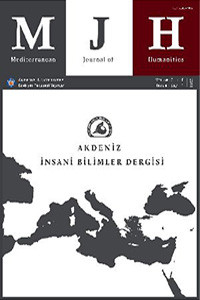Laughing at Knights: Representations of Humour in Sir Perceval of Galles, Sir Beues of Hamtoun, Lybeaus Desconus and Geoffrey Chaucer’s Tale of Sir Thopas
Öz
Romance conventions, motifs and archetypes blend in order to appeal to the moral concerns of the romance audience. In particular, chivalric romances are heroic narratives adapted to English feudalism and the Christian faith, either to depict a knight’s moral progress or the aristocratic way of life; therefore, romance would seem to be the last place one would look for humour. Much of the humour in medieval romance is the effect of the exaggeration of heroic expressions and deeds, which then becomes mocking and ridiculous rather than heroic. This article concentrates on the representations of humour in Sir Perceval of Galles, Sir Beues of Hamtoun, Lybeaus Desconus and Geoffrey Chaucer’s Tale of Sir Thopas. It discusses what makes these romances humorous, how the romance heroes are presented as laughable figures, while it argues the function of humour in these romances. The romance heroes and situations are compared, and they are presented in detail with specific examples from these romances. Romance as a humorous genre is discussed as to if its use is for humour as a means of laughter, for satire or for emphasis upon the idea of chivalry. By arguing the humorous nature of these romances, this article discusses how romance -the genre of noble characters- is ridiculed and becomes ordinary, while the virtues it represents are highlighted.
Anahtar Kelimeler
Middle English Romance Humour Sir Perceval of Galles Sir Beues of Hamtoun Lybeaus Desconus Geoffrey Chaucer’s Tale of Sir Thopas
Kaynakça
- Barron W. R. J. (1987). English Medieval Romance. Harlow 1987.
- Baugh A. C. (1967). “The Middle English Romance: Some Questions of Creation, Presentation, and Reservation”. Speculum 42/1 (1967) 1-31.
- Benson L. (2008). Riverside Chaucer. Oxford 2008.
- Boffey J. (2007). “From Manuscript to Modern Text”. Ed. P. Brown. A Companion to Medieval English Literature: c. 1350-c. 1500 (2007) 107-122. Oxford.
- Braswell M. F. (1995). Sir Percevall of Galles and Ywain and Gawain. Michigan 1995.
- Brewer D. (2004). “The Popular English Metrical Romances”. Ed. C. J. Saunders. A Companion to Romance: From Classical to Contemporary (2004) 45-64. Oxford.
- Brewer D. (2002). “Chivalry”. Ed. P. Brown. A Companion to Chaucer (2002) 58-74. Oxford.
- Broughton-Willett T. H. (1992). Imperfect Analogies: Parody in Chaucer and Medieval Literature Amherst (1992).
- Burrow J. A. (1984). “Chaucer’s Sir Thopas and la Prise de Nuevile”. The Yearbook of English Studies 14 (1984) 44-55.
- Cawsey K. (2011). Twentieth-Century Chaucer Criticism: Reading Audiences. Surrey 2011.
- Charney M. (2005). Comedy: A Geographic and Historical Guide. Vol. 1. Westport 2005.
- Childress D. (1978). “Between Romance and Legend: ‘Secular Hagiography’ in Middle English Literature”. Philological Quarterly 57/3 (1978) 311-322.
- Echard S. (1996). “Of Parody and Perceval: Middle Welsh and Middle English Manipulations of the Perceval Story”. Nottingham Medieval Studies 40 (1996) 63-79.
- Eckhardt C. D. (1974). “Arthurian Comedy: The Simpleton-Hero in Sir Perceval of Galles”. The Chaucer Review 8/3 (1974) 205-220.
Ayrıntılar
| Birincil Dil | Türkçe |
|---|---|
| Konular | İngiliz ve İrlanda Dili, Edebiyatı ve Kültürü |
| Bölüm | Araştırma Makaleleri |
| Yazarlar | |
| Yayımlanma Tarihi | 30 Haziran 2016 |
| Yayımlandığı Sayı | Yıl 2016 Cilt: 6 Sayı: 1 |

